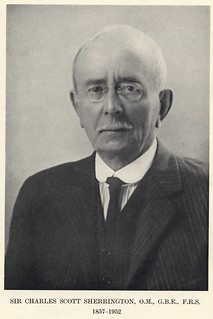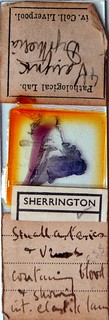At a 1948 meeting described by Nature as an ‘informal gathering of some men of science’, the then director of the Lister Institute, Dr Alan N. Drury, related a story regarding the early years of the Brown Institute, the first veterinary hospital in London. Holding up a horse hoof that Drury claimed came from one of the Brown’s early inhabitants, he described how “Tommy” (as the horse had been known) had in 1893-4 played a key part in the saving of a young child’s life. Tommy had been the first animal in England to be used in the creation of a drug to treat diphtheria, at that time a major cause of death amongst children. To this end, he had been injected with diphtheria toxin by Dr Marc Armand Ruffer, and Charles Sherrington, two of the leading physiologists in the country at that time. Their intention had been to induce Tommy’s body to manufacture an antitoxin for the disease. As it happened, the diptheria antitoxin in Tommy’s blood would have a rather more immediate use than either of these physiologists could have imagined.
Horses played a critical role in Britain's economy during the late nineteenth century. Because of their ubiquity in the seemingly ever-expanding urban environments of cities such as London, Manchester and Liverpool, the relation of equine and human health had become a matter of great concern. For example, one of the more insidious problems affecting London’s transport system at this time was its reliance on animals who tended to be overworked, underfed, and as often as not disease-ridden. As Sherrington noted in a letter to The Times of August 12 1892, the Brown Institute saw a great deal of the ‘poor class of owners’ of horses, who could not afford to lose the income generated by their charges for more than a few days. Owners were often unwilling to acknowledge the presence of diseases such as ‘glanders and farcy’, which, if discovered, necessitated the destruction of the animals concerned. Left unchecked, these diseases could be passed through drinking troughs and fountains to the general population, as well as other animals. Sherrington highlighted that owners were not compensated for the loss of their animals, so many remained unwilling to present their horses and donkeys for examination. Unfortunately, this created conditions for increased spread of the disease.
Sherrington had more than the passing interest in glanders indicated by this letter. On the 24th of September 1892, the British Medical Journal announced that he had been experimenting with a new diagnostic test for the disease that he had received from Pierre Paul Émile Roux, co-founder of the Institut Pasteur in Paris. ‘Mallein’, as the substance used for this test was called, had been developed by the Russian researcher Otto Kalning, using a technique invented by the German bacteriologist Robert Koch for the treatment of tuberculosis. Injecting the disease into a healthy animal, cultivating a sample of it, and then using a microscope to compare that sample with the blood of an animal suspected of being infected presented physiologists with what they believed to be a more effective way of testing for infection. Although the BMJ reported that Sherrington's test had not proved quite as effective as the French strain, it nevertheless marked the first adoption of a bacteriological test for glanders in Britain.
Sherrington and Ruffer went on to experiment with horses for the diagnosis and treatment of other, even more challenging diseases. Not least amongst these was the above-mentioned diphtheria experiment of 1894. Years later, in a letter (quoted in the abovementioned Nature article), Sherrington recalled how his nephew George, then only seven, had fallen ill with the disease shortly after Tommy the horse had received his first injection. Though the two physiologists were completely in the dark as to whether or not the antitoxin was ready for trial, the urgency of the case demanded immediate action. Sherrington bled Tommy by lantern-light on the night that he heard the news, and took the first train to Lewes to attend to his stricken relative. Despite the weakness of the boy, and a dire prognostication from the local doctor, the injection of the antitoxin soon had the desired effect. Sherrington recalled his nephew's rapid recovery, and how news of it quickly spread amongst the physiological community of Britain, thereby boosting the reputatuion of Ruffer and himself.
Horses such as Tommy exemplify the changing roles that animals were coming to play in late nineteenth-century Britain. As horses' use in transportation and hard labour began to decline, some found themselves caught up in the rather more specialist world of physiological research. Instead of ferrying people and goods from place to place, such animals were given a new purpose – as unwitting generators of new medicines and novel diagnostic techniques.
See also: http://www.historyofvaccines.org/content/timelines/diphtheria and http://www.museumofhealthcare.ca/explore/exhibits/vaccinations/diphtheria.html
- No links match your filters. Clear Filters
-
Cites
 Mallein: The New Diagnostic for Glanders. British Medical Journal, 24 September 1892 (2), p. 700.
Mallein: The New Diagnostic for Glanders. British Medical Journal, 24 September 1892 (2), p. 700.
Description:'One of the chief difficulties attached to the stamping out of glanders in the stable or elsewhere is the difficulty of recognising the disease in its earliest stages. Koch's discovery of tuberculin, and its employment for the diagnosis of tuberculosis, awakened the idea of employing in a similar way, a product of the bacillus of glanders for the diagnosis of glanders and farcy in suspicious cases. In February, 1891, it was reported that in the bacteriological laboratory of the Veterinary Institute at Dorpat an extract had been prepared from the bacillus mallei by means of which the diagnosis of the disease in doubtful cases was assured. This welcome news was, however, shortly followed by the melancholy addendum that Dr. Kalning, the discoverer of the preparation, had contracted the disease himself, and had died.' (701)
'At the Brown Institute mallein kindly furnished by M. Roux, of the Institut Pasteur, As well as some prepared by professor Sherrington at the Institution, has for some time been under trial in London. The results at present obtained have not been altogether so thoroughly satisfactory as those reported from Dantzic; but the number of cases in which trial has been made is still insufficient to afford a basis for positive opinion. (702)



![Sherrington-Senior Treasurer [Drury], 15/11/1947 (WCG 28.1)](http://farm4.staticflickr.com/3716/13738845763_74d8044c0a_n.jpg)





